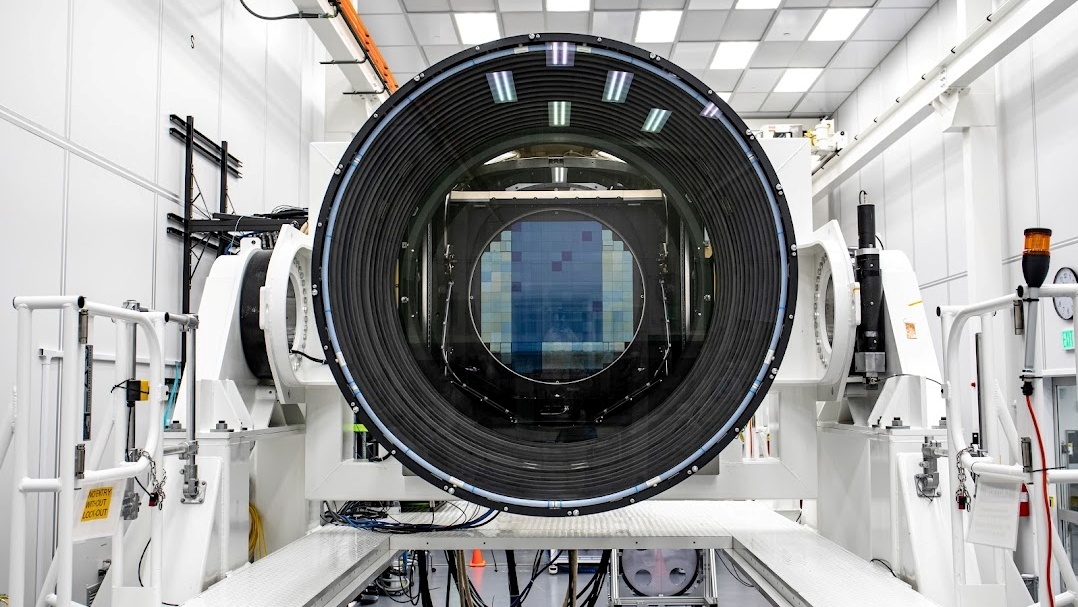The LSST will capture half the night sky in time lapse for over 10 years. (Image: lsst.org)
We live in a time in which we can explain the universe theoretically, but still have no answers to a large number of questions. The scientists from the Vera C. Rubin Observatory want to use the world’s largest camera to answer some of these questions.
The Legacy Survey of Space and Time
, or simply LSST, to create a 10-year time-lapse of the southern night sky. It should be possible to make movements in our universe visible for the first time and enable us to to see the universe on a time scale.
This would make it possible, for example, to observe the movements of galaxies, study supernovae better, discover unknown objects and visualize the expansion of the universe. The researchers hope to make discoveries with the LSST that will turn our worldview upside down.
The technical details are very impressive
The LSST is about 3 meters long, 1.65 meters high and weighs an impressive 2800 kilograms. The image sensors, i.e. the recording surface, together form a diameter of 64 centimeters. For comparison: the image sensor of a professional camera with a full-frame sensor measures 24 x 36 millimeters.
To fill such an area with pixels, a total of 189 16-megapixel sensors were arranged in a mosaic, which together form a Form a recording surface with 3200 megapixels. In order to be able to display the widest possible color spectrum sharply, built-in color filters are used, which enable the LSST to capture light from ultraviolet to infrared.
The f/1.2 aperture is bright enough to clearly display the night sky and keep exposure times short.
Such a large camera, which is packed with electronics, also has to be cooled accordingly. Heat not only damages the electronics, but can also have a negative effect on the images. Especially in terms of image noise.
With the researchers in one picture, the size of the camera becomes much more apparent. (Image: lsst.org)
This is particularly important for the researchers, as the most interesting discoveries of the universe have been made, mostly in the darkest areas of the images. If the image is too noisy, important details in these areas are lost.
In order to cool the LSST sufficiently, a cryostat system was developed for the camera, that keeps the components down to minus 130° Celsius.
A plethora of data for the whole world
In contrast to the recently launched James Webb telescope, which takes a deep look into the universe with a narrow field of view, the LSST is intended to have a very wide field of view in order to display as much as possible at once. The camera will take a picture of one area of the night sky every thirty seconds before moving to another area.
Each of these 3200 megapixel images will be around 12 gigabytes in size and so thousands of these huge photos are created every night for a total period of 10 years. The result is hundreds of petabytes of data. The images can be viewed directly in the observatory so that the researchers can carry out basic analyses.
The actual storage, deep analysis and processing of the data is distributed all over the world. Much of the analysis is done by artificial intelligence, as it is simply impossible for humans to process such a large amount of data without error.
Nevertheless, it should be possible to call up the image material for each person and take a look at the universe yourself. When something changes in the night sky, notifications are sent to astronomers around the world so everyone can see for themselves.
The camera took more than two decades to develop and cost $168 million. She is scheduled to start her ten-year project in spring 2023 at the Rubin Observatory in Chile. The last tests are currently being carried out in Stanford National Accelerator Laboratory
SLAC for short, before being dismantled and transported to Chile.
If you not only want to know what the universe looks like, but also how it sounds, then have a look here:
Be sure to listen! The universe sometimes sounds soothing – and sometimes frightening
Are you excited about what discoveries can be made with the LSST and would you activate the notifications for events in space? Write us your opinion in the comments!










